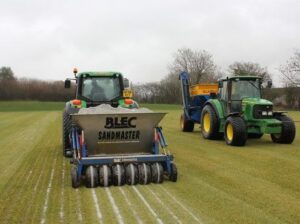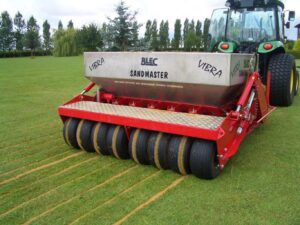Sand Banding
March 22, 2024
Dear Member
Over winter ’24-’25 we have not been standing still. In December we commissioned the professional services of Robert.G.Donald BEng (Hons) CEnv MI AgrE, Independent Sports Pitch & Landscape Construction Consultant; an expert in effective drainage practices within golf courses.
Robert was commissioned to report on the efficiency of our existing drainage, current and planned drainage works and to conclude with a professionally advised works schedule aimed at improving course conditions and extending annual playability.
Having spent time on the golf course with Robert and course manager Mark, and entered many subsequent conversations regarding our site, we are clear on the main actions requiring our time and investment. Nothing revelatory, but definitive and detailed processes for us to follow –
- Perform additional clearing of existing ditches and water outlets, as these allow whatever water we manage to get off the golf course to move away. The work needs to form a significant part of the green keeping teams’ autumn program and must be undertaken annually. It will ensure the benefits of all our additional efforts are maximised. The need for diggers means we must complete before the autumn/winter rains come.
- Primary drainage. Maintain and add to the laterals and mainlines we already have in place. New drains should be installed at a recommended spacing no greater than 6 metres apart, due the short distance water is able to travel through our soil.
- Link up the primary drainage with secondary drainage (recommend sand banding for your soil profile). This will ensure water is able to travel further through the soil to reach the primary drains and then continue its journey out via the cleared existing ditches and water outlets.
Most of our primary drainage is only 8 years old and with a potential lifespan of 15-25 years, should not be considered redundant. It is however probable that the drains are not working optimally. A significant contributor to this is that ironically, not enough water is running through them. The primary lines drain < 6-12 inches on either side yet the large amount of water which is held in between is unable to travel far enough through the soil to reach them.
The missing component here has been secondary drainage which will facilitate a significant increase in the amount of water reaching the drains. They will then be forced to work harder and in effect be ‘flushed through’, meaning performance will improve.
Once the sand banding is in place, we will be able to accurately assess how well the existing primary drainage is performing and add to or replace as necessary. It makes no sense to add primary drains without first linking the existing ones with secondary banding. Primary and secondary drainage can be undertaken in any order, meaning one does not need to precede the other.
After that it will be a case of replacing primary drains at the end of their efficient life and adding more where required, finishing with secondary sand banding on top as per the specifications given to us by Robert.
Getting any sand we can onto our golf course is a benefit and the presence of our 2-years’ worth of sand dressing was clearly visible in the core samples he took. Robert reported – ‘The course management team’s current maintenance schedule of fairway sand top dressing and verti-draining is recommended to be continued as benefits of such activities may be realised incrementally over a prolonged period. Sand top dressing on clay loam soils will improve surface uniformity and firmness, deter thatch buildup, deter worm activity and gradually (over a prolonged period) improve the upper topsoil soil textual analysis from a clay loam to a sandy clay loam. This will eventually improve surface drainage characteristics once a sufficient depth of sand has been established. Sand top dressing will also assist preservation of secondary drainage installations as it will contribute to keeping the sand bands opened textured at the surface and resist contamination from worm casts and grass clippings.’




We will be sand banding 3 hectares worth of fairways, nearly half our total fairway area, focusing on linking those areas with existing primary drainage, the areas which suffer most in periods of heavy rainfall. Spring is the optimal time for this installation, as recovery is quickest and bands will be fully established by winter. A local GUR rule will be required in the short term and will be issued in time for commencement of the works.
COURSE UPDATE


Clearly this has been another wet winter. Even though we had a very decent January, with buggies out at the end of the month, winter (Oct-Mar inclusive) has seen 31% more rain against our 7-year average. For the most part we coped well, with very similar closure/limitation conditions as other clubs in the local area. This month however we have been up against it and although a lot of members have taken advantage of the pro-shop carry bag and trolley offer, and therefore made use of the course, it is undeniably time for us to see some better weather.
However, the greenkeeping team don’t get to dodge the weather and have been diligently progressing with the winter plan which is now over 90% complete. You will have noticed the bunkers to the left of the 3rd fairway have been dug out ready for turfing. These were filled in a few years ago, but never recovered properly. Most of the year they have therefore been bare and filled with weeds and stones. Hopefully upon completion in April the finish and playability will be hugely improved.
The bunker to the right of the 8th fairway is also prepped and ready for filling and turfing. For most of the winter this bunker sits on the water line of the lake. Therefore, it’s rarely able to drain sufficiently for play. It also sits on top of the primary drain shifting water from the fairway to the lake. With the drain line pivotal to creating better fairway conditions, the only way for the bunker to be in play all year round without the risk of play damaging the pipe, would be to raise it around 18-24 inches and rebuild. In the short term, this is not in the plan and so it will be filled, turfed and put back in play.
COURSE MAINTENANCE
This week the green keeping team have been getting in front by pro-coring (solid tining) all tees. Next Wednesday Turf Tonics are back to scarify and collect them all. Our team will then top dress all the tees and over-seed as required. On Monday & Tuesday all greens will be pro-cored with 19mm solid tines to a depth of 140mm. They will then be ironed and top dressed, with 3 passes planned to brush in. In the week following all approaches to greens will be pro-cored and top dressed, with little or no impact on play.
Thank you for your patience. There is rain forecast again next week (just for a change), and combined with slowly rising temperatures, this should see a nice quick recovery after the week of maintenance.
THANK YOU
To all those members who pop their heads around my door to offer feedback on the golf course conditions, thank you! So many of you start the conversation with ‘I’m not complaining……..’ but I never take feedback in that manner. Every comment is appreciated and taken on board, discussed with the green keeping team and actions taken or responses given when required. Hopefully for the most part I am informed and able to answers your concerns, albeit maybe not always with the answers you are hoping for.
We are constantly looking for the best ways to improve the golf course. Often being creative with our thinking as we strive to live within our means. The 5-year course plan is a live document and as such constantly being re-evaluated. It is by no means a fait accompli and if there are better ways to invest in and improve the playing experience for all members, then we will always attempt to do that.
All the best
Simon
General manager